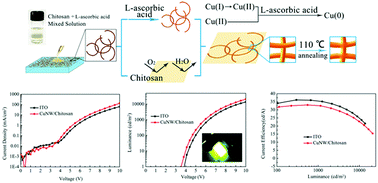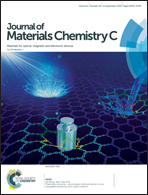Highly robust and ultrasmooth copper nanowire electrode by one-step coating for organic light-emitting diodes
Abstract
A novel copper nanowire (CuNW)/chitosan composite transparent electrode is fabricated via a simple one-step solution process in ambient air, and the resulting film shows high electrical conductivity and air stability, low surface roughness and enhanced transmittance. After coating with chitosan dissolved in L-ascorbic acid solution, the copper oxide layer on the surface of pristine CuNW reacts with L-ascorbic acid and is reduced to metal copper. Meanwhile, under the effective protection of chitosan, CuNWs are welded well by thermal annealing in air, resulting in relatively low sheet resistance of 19 Ω sq−1 with transmittance of 81%. The chitosan fills the gaps between nanowires, and the nanostructure becomes more uniform, resulting in low root mean square (RMS) of 6.2 nm and enhancement in transmittance. This CuNW composite film can resist water/ethanol immersion and an aging test at 120 °C on a hot plate in air environment without clear conductivity deterioration. Since the film can be easily removed by an acid–base solution, it allows a feasible patterning process. After employing this film as the anode in an OLED device, the device shows higher performance than the device based on an ITO anode.



 Please wait while we load your content...
Please wait while we load your content...